If you’re new to tracking the success of a social media campaign, all of the jargon can get confusing. Still, it’s important to look at these metrics to determine how you can adjust and optimize your strategy.
I’m going to walk you through the metrics that will be worth watching for you and your campaign. Of course, all of that begins with establishing a goal!
Choosing a Goal
It’s impossible to say, “Always track these metrics,” because the key performance indicators (the metrics that are relevant to your campaign, also known as KPI) will change depending on your goal. The first step in identifying your goal is to look at what you need.
Let’s say you want to see some additional revenue from your social media marketing strategy. You’re looking to increase sales, so you should focus on the metrics:
- Conversions: When customers take a specific action as determined by your campaign. This can be downloading an ebook, signing up for your newsletter, making a purchase, etc. For a sales goal, tracking the number of people who click on your ad and make a purchase is absolutely vital!
- Clicks: Exactly what they sound like! The number of clicks you get on ads and posts can increase your web traffic, which means more people are browsing your site and considering making purchases.
Measuring these KPIs lets you see how to improve the number of sales that your strategy generates. If you find that your posts/ads aren’t being clicked on, then you know it’s time to change things up and restructure your posts to be more inviting to your audience.
Or maybe you’re a new business. You’ve got a good product and a great team, but not many people know about you yet. For your campaign, I’d suggest tracking:
- Reach: The number of people who see your post or ad. Focusing on reach will get the word out about your business and help build your follower count.
- Brand Awareness: How aware the public is of your business. Can they recognize your name and logo? Brand awareness is key to developing a following for your growing business!
It can take a long time, but nobody can buy from you if they don’t know who you are! A bigger audience will also make you more credible. If a potential customer is weighing between your product and a competitor’s, the side that has a larger following will seem more trustworthy.
What about once you’ve got a large audience? Well, then it’s time to focus on quality. What good are 10,000 page likes if nobody is interacting with your posts? As you work on getting more interaction, you’ll be following this KPI:
- Engagement: The number of likes/comments/shares/interactions your posts generate. A horde of followers is great to have, but a smaller audience of people who are interacting with your content and your brand is usually going to be more important.
When evaluating the quality of your audience, engagement should be a major factor. Not only does the increased interaction on your posts make your brand look better, but it shows that users are getting value from your content marketing strategy. That’s a great sign, and when you’re noticing low engagement, it may be time to reexamine how you’re appealing to your audience!
Choose Wisely
Everyone wants to have a better social media marketing strategy, but not everyone wants to put the work into finding ways to improve. You need to find the right KPIs that align with your goals and keep a close eye on them. Once you’ve identified the trends across your chosen metric, you’ll be ready to make an actionable plan to craft an even better campaign!
Do you want to talk strategy with experienced marketing experts? Set up your free consultation with The Go! Agency!
Read More






